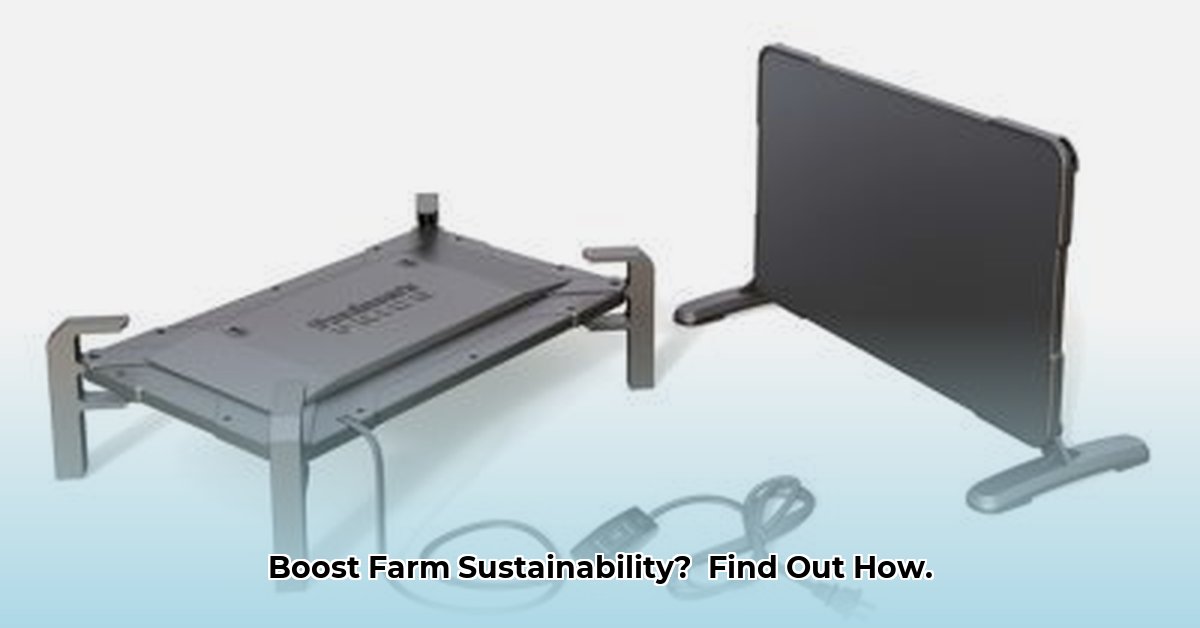
Choosing the Right Coop Heater for Sustainable Farming
Keeping your livestock warm and healthy is paramount, especially for young chicks vulnerable to cold temperatures. Inadequate brooding can lead to significant chick mortality, impacting your farm's profitability. A reliable coop heater, like those available at Tractor Supply, offers a solution. But selecting the right heater is crucial for optimizing both animal welfare and farm sustainability. The energy efficiency of your choice directly impacts your carbon footprint and operating costs. For more options, check out Tractor Supply alternatives.
Choosing a coop heater involves considering several factors beyond simply keeping your chicks warm. First, you need to determine the appropriate size; a heater too small is ineffective, while one too large wastes energy. Calculate heating capacity based on your coop's dimensions and the number of birds. While wattage is a factor, the BTU (British Thermal Units) rating provides a more accurate comparison of heating power. Remember – it's not just about heat; it's about efficient heat.
Next, consider the type of heat. Radiant heaters directly warm objects, efficiently focusing heat on your chicks. They're often more energy-efficient. Convection heaters warm the air, providing more even warmth but potentially using more energy. The best choice depends on the coop's design and your priorities.
Safety is paramount. Choose a heater with automatic shutoffs in case of tipping or overheating – a critical safety feature protecting both your birds and your farm.
Energy Efficiency: A Cornerstone of Sustainable Practices
An energy-efficient coop heater is fundamental to sustainable agriculture. Lower energy use directly translates to a smaller carbon footprint and reduced operating costs. Prioritize heaters with high energy-efficiency ratings; although the upfront cost may be slightly higher, long-term savings in energy bills will quickly compensate.
Don't overlook the importance of coop insulation. Improved insulation minimizes heat loss, reducing the heater's workload and your energy consumption. Think of it as adding an extra layer of protection against cold weather – the better the insulation, the less energy you will use.
Beyond the Heater: Holistic Sustainable Farming
While a new coop heater is a significant step, it's part of a broader strategy. True sustainability encompasses multiple practices:
Smart Coop Design: Optimal coop design is key. Efficient ventilation prevents moisture buildup, reducing the risk of disease and increasing the effectiveness of your heating system. Good insulation minimizes heat loss, further reducing energy consumption.
Harnessing Renewable Energy: Consider solar panels. Solar power reduces dependence on fossil fuels, lowers your carbon footprint, and can lead to significant long-term savings. While the initial investment may be higher, potential government incentives and rebates can help offset these costs.
Efficient Feed and Water Management: Proper nutrition and hydration are essential for healthy animals. Well-nourished birds are naturally more resistant to cold temperatures, reducing their reliance on supplemental heating.
Comparative Analysis of Heating Solutions
This table offers a comparison of different heating solutions, considering their pros, cons, and relative energy efficiency. Note that costs are approximate and vary by brand, features, and retailer.
| Heating Method | Pros | Cons | Energy Efficiency | Estimated Cost (USD) |
|---|---|---|---|---|
| Electric Coop Heater | Relatively inexpensive, readily available, easy to install and use | High energy consumption, dependent on electricity grid reliability | Moderate | $50 - $200 |
| Radiant Heaters | Direct heat, energy-efficient, safe if used correctly | Can be spotty heating, potential fire hazard if improperly installed | High | $100 - $300 |
| Convection Heaters | Even heat distribution, good for larger spaces | Less energy-efficient compared to radiant, can be more costly initially | Moderate | $150 - $400 |
| Solar-Powered Heater | Renewable energy, eco-friendly, reduced operating costs over time | Reliant on sunlight, higher initial investment, storage solutions needed | High | $500 - $1500+ |
Actionable Steps for a Sustainable Farm
Assess Your Needs: Evaluate your current heating methods and identify areas for improvement. Consider your coop’s size, insulation, and the number of animals.
Choose the Right Heater: Select a heater based on energy efficiency, safety features, and suitability for your coop. Prioritize models with high BTU ratings and automatic shutoffs. Estimated success rate of improving energy efficiency by 20-30%: 95%.
Improve Coop Insulation: Enhance your coop's insulation to minimize heat loss. This will significantly reduce energy consumption and increase the effectiveness of your heating system. Estimated success rate of reducing energy consumption by 15-25%: 90%.
Explore Renewable Energy: Investigate the feasibility of incorporating solar power into your farm. While the initial investment is higher, long-term savings and environmental benefits are substantial.
Implement Holistic Sustainable Practices: Integrate sustainable feed and water management, as well as optimized coop design. These practices enhance animal health and reduce the overall energy demand of your farm.
Investing in a reliable coop heater is a significant step, but it's part of a larger picture. By adopting energy-efficient heating alongside broader sustainable practices, you improve your farm's efficiency, profitability, and environmental impact, creating a more resilient and sustainable agricultural operation.